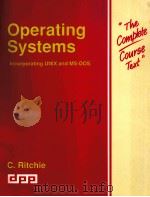《MODERN OPERATING SYSTEMS》
| 作者 | ANDREW S.TANENBAUM 编者 |
|---|---|
| 出版 | 未查询到或未知 |
| 参考页数 | 952 |
| 出版时间 | 没有确切时间的资料 目录预览 |
| ISBN号 | 7111091566 — 求助条款 |
| PDF编号 | 812399488(仅供预览,未存储实际文件) |
| 求助格式 | 扫描PDF(若分多册发行,每次仅能受理1册) |
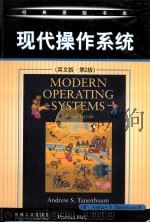
1INTRODUCTION1
1.1.WHAT IS AN OPERATING SYSTEM?3
1.1.1.The Operating System as an Extended Machine3
1.1.2.The Operating System as a Resource Manager5
1.2.HISTORY OF OPERATING SYSTEMS6
1.2.1.The First Generation (1945-55)6
1.2.2.The Second Generation (1955-65)7
1.2.3.The Third Generation (1965-1980)9
1.2.4.The Fourth Generation (1980-Present)13
1.2.5.Ontogeny Recapitulates Phylogeny16
1.3.THE OPERATING SYSTEM ZOO18
1.3.1.Mainframe Operating Systems18
1.3.2.Server Operating Systems19
1.3.3.Multiprocessor Operating Systems19
1.3.4.Personal Computer Operating Systems19
1.3.5.Real-Time Operating Systems19
1.3.6.Embedded Operating Systems20
1.3.7.Smart Card Operating Systems20
1.4.COMPUTER HARDWARE REVIEW20
1.4.1.Processors21
1.4.2.Memory23
1.4.3.I/O Devices28
1.4.4.Buses31
1.5.OPERATING SYSTEM CONCEPTS34
1.5.1.Processes34
1.5.2.Deadlocks36
1.5.3.Memory Management37
1.5.4.Input/Output38
1.5.5.Files38
1.5.6.Security41
1.5.7.The Shell41
1.5.8.Recycling of Concepts43
1.6.SYSTEM CALLS44
1.6.1.System Calls for Process Management48
1.6.2.System Calls for File Management50
1.6.3.System Calls for Directory Management51
1.6.4.Miscellaneous System Calls53
1.6.5.The Windows Win32 API53
1.7.OPERATING SYSTEM STRUCTURE56
1.7.1.Monolithic Systems56
1.7.2.Layered Systems57
1.7.3.Virtual Machines59
1.7.4.Exokemels61
1.7.5.Client-Server Model61
1.8.RESEARCH ON OPERATING SYSTEMS63
1.9.OUTLINE OF THE REST OF THIS BOOK65
1.10.METRIC UNITS66
1.11.SUMMARY67
2PROCESSES AND THREADS71
2.1.PROCESSES71
2.1.1.The Process Model72
2.1.2.Process Creation73
2.1.3.Process Termination75
2.1.4.Process Hierarchies76
2.1.5.Process States77
2.1.6.Implementation of Processes79
2.2.THREADS81
2.2.1.The Thread Model81
2.2.2.Thread Usage85
2.2.3.Implementing Threads in User Space90
2.2.4.Implementing Threads in the Kernel93
2.2.5.Hybrid Implementations94
2.2.6.Scheduler Activations94
2.2.7.Pop-Up Threads96
2.2.8.Making Single-Threaded Code Multithreaded97
2.3.INTERPROCESS COMMUNICATION100
2.3.1.Race Conditions100
2.3.2.Critical Regions102
2.3.3.Mutual Exclusion with Busy Waiting103
2.3.4.Sleep and Wakeup108
2.3.5.Semaphores110
2.3.6.Mutexes113
2.3.7.Monitors115
2.3.8.Message Passing119
2.3.9.Barriers123
2.4.CLASSICAL IPC PROBLEMS124
2.4.1.The Dining Philosophers Problem125
2.4.2.The Readers and Writers Problem128
2.4.3.The Sleeping Barber Problem129
2.5.SCHEDULING132
2.5.1.Introduction to Scheduling132
2.5.2.Scheduling in Batch Systems138
2.5.3.Scheduling in Interactive Systems142
2.5.4.Scheduling in Real-Time Systems148
2.5.5.Policy versus Mechanism149
2.5.6.Thread Scheduling150
2.6.RESEARCH ON PROCESSES AND THREADS151
2.7.SUMMARY152
3DEADLOCKS159
3.1.RESOURCES160
3.1.1.Preemptable and Nonpreemptable Resources160
3.1.2.Resource Acquisition161
3.2.INTRODUCTION TO DEADLOCKS163
3.2.1.Conditions for Deadlock164
3.2.2.Deadlock Modeling164
3.3.THE OSTRICH ALGORITHM167
3.4.DEADLOCK DETECTION AND RECOVERY168
3.4.1.Deadlock Detection with One Resource of Each Type168
3.4.2.Deadlock Detection with Multiple Resource of Each Type171
3.4.3.Recovery from Deadlock173
3.5.DEADLOCK AVOIDANCE175
3.5.1.Resource Trajectories175
3.5.2.Safe and Unsafe States176
3.5.3.The Banker's Algorithm for a Single Resource178
3.5.4.The Banker's Algorithm for Multiple Resources179
3.6.DEADLOCK PREVENTION180
3.6.1.Attacking the Mutual Exclusion Condition180
3.6.2.Attacking the Hold and Wait Condition181
3.6.3.Attacking the No Preemption Condition182
3.6.4.Attacking the Circular Wait Condition182
3.7.OTHER ISSUES183
3.7.1.Two-Phase Locking183
3.7.2.Nonresource Deadlocks184
3.7.3.Starvation184
3.8.RESEARCH ON DEADLOCKS185
3.9.SUMMARY185
4MEMORY MANAGEMENT189
4.1.BASIC MEMORY MANAGEMENT190
4.1.1.Monoprogramming without Swapping or Paging190
4.1.2.Multiprogramming with Fixed Partitions191
4.1.3.Modeling Multiprogramming192
4.1.4.Analysis of Multiprogramming System Performance194
4.1.5.Relocation and Protection194
4.2.SWAPPING196
4.2.1.Memory Management with Bitmaps199
4.2.2.Memory Management with Linked Lists200
4.3.VIRTUAL MEMORY202
4.3.1.Paging202
4.3.2.Page Tables205
4.3.3.TLBs—Translation Lookaside Buffers211
4.3.4.Inverted Page Tables213
4.4.PAGE REPLACEMENT ALGORITHMS214
4.4.1.The Optimal Page Replacement Algorithm215
4.4.2.The Not Recently Used Page Replacement Algorithm216
4.4.3.The First-In, First-Out217
4.4.4.The Second Chance Page Replacement Algorithm217
4.4.5.The Clock Page Replacement Algorithm218
4.4.6.The Least Recently Used218
4.4.7.Simulating LRU in Software220
4.4.8.The Working Set Page Replacement Algorithm222
4.4.9.The WSClock Page Replacement Algorithm225
4.4.:Summary of Page Replacement Algorithms227
4.5.MODELING PAGE REPLACEMENT ALGORITHMS228
4.5.1.Belady's Anomaly229
4.5.2.Stack Algorithms229
4.5.3.The Distance String232
4.5.4.Predicting Page Fault Rates233
4.6.DESIGN ISSUES FOR PAGING SYSTEMS234
4.6.1.Local versus Global Allocation Policies234
4.6.2.Load Control236
4.6.3.Page Size237
4.6.4.Separate Instruction and Data Spaces239
4.6.5.Shared Pages239
4.6.6.Cleaning Policy241
4.6.7.Virtual Memory Interface241
4.7.IMPLEMENTATION ISSUES242
4.7.1.Operating System Involvement with Paging242
4.7.2.Page Fault Handling243
4.7.3.Instruction Backup244
4.7.4.Locking Pages in Memory246
4.7.5.Backing Store246
4.7.6.Separation of Policy and Mechanism247
4.8.SEGMENTATION249
4.8.1.Implementation of Pure Segmentation253
4.8.2.Segmentation with Paging: MULTICS254
4.8.3.Segmentation with Paging: The Intel Pentium257
4.9.RESEARCH ON MEMORY MANAGEMENT262
4.10.SUMMARY262
5INPUT/OUTPUT269
5.1.PRINCIPLES OF I/O HARDWARE269
5.1.1.I/O Devices270
5.1.2.Device Controllers271
5.1.3.Memory-Mapped I/O272
5.1.4.Direct Memory Access276
5.1.5.Interrupts Revisited279
5.2.PRINCIPLES OF I/O SOFTWARE282
5.2.1.Goals of the I/O Software283
5.2.2.Programmed I/O284
5.2.3.Interrupt-Driven I/O286
5.2.4.I/O Using DMA287
5.3.I/O SOFTWARE LAYERS287
5.3.1.Interrupt Handlers287
5.3.2.Device Drivers289
5.3.3.Device-Independent I/O Software292
5.3.4.User-Space I/O Software298
5.4.DISKS300
5.4.1.Disk Hardware300
5.4.2.Disk Formatting315
5.4.3.Disk Arm Scheduling Algorithms318
5.4.4.Error Handling322
5.4.5.Stable Storage324
5.5.CLOCKS327
5.5.1.Clock Hardware328
5.5.2.Clock Software329
5.5.3.Soft Timers332
5.6.CHARACTER-ORIENTED TERMINALS333
5.6.1.RS-232 Terminal Hardware334
5.6.2.Input Software336
5.6.3.Output Software341
5.7.GRAPHICAL USER INTERFACES342
5.7.1.Personal Computer Keyboard, Mouse, and Display Hardware343
5.7.2.Input Software347
5.7.3.Output Software for Windows347
5.8.NETWORK TERMINALS355
5.8.1.The X Window System356
5.8.2.The SLIM Network Terminal360
5.9.POWER MANAGEMENT363
5.9.1.Hardware Issues364
5.9.2.Operating System Issues365
5.9.3.Degraded Operation370
5.10.RESEARCH ON INPUT/OUTPUT371
5.11.SUMMARY372
6FILE SYSTEMS379
6.1.FILES380
6.1.1.File Naming380
6.1.2.File Structure382
6.1.3.File Types383
6.1.4.File Access385
6.1.5.File Attributes386
6.1.6.File Operations387
6.1.7.An Example Program Using File System Calls389
6.1.8.Memory-Mapped Files391
6.2.DIRECTORIES393
6.2.1.Single-Level Directory Systems393
6.2.2.Two-level Directory Systems394
6.2.3.Hierarchical Directory Systems395
6.2.4.Path Names395
6.2.5.Directory Operations398
6.3.FILE SYSTEM IMPLEMENTATION399
6.3.1.File System Layout399
6.3.2.Implementing Files400
6.3.3.Implementing Directories405
6.3.4.Shared Files408
6.3.5.Disk Space Management410
6.3.6.File System Reliability416
6.3.7.File System Performance424
6.3.8.Log-Structured File Systems428
6.4.EXAMPLE FILE SYSTEMS430
6.4.1.CD-ROM File Systems430
6.4.2.The CP/M File System435
6.4.3.The MS-DOS File System438
6.4.4.The Windows 98 File System442
6.4.5.The UNIX V7 File System445
6.5.RESEARCH ON FILE SYSTEMS448
6.6.SUMMARY448
7MULTIMEDIA OPERATING SYSTEMS453
7.1.INTRODUCTION TO MULTIMEDIA454
7.2.MULTIMEDIA FILES458
7.2.1.Audio Encoding459
7.2.2.Video Encoding461
7.3.VIDEO COMPRESSION463
7.3.1.The JPEG Standard464
7.3.2.The MPEG Standard467
7.4.MULTIMEDIA PROCESS SCHEDULING469
7.4.1.Scheduling Homogeneous Processes469
7.4.2.General Real-Time Scheduling470
7.4.3.Rate Monotonic Scheduling472
7.4.4.Earliest Deadline First Scheduling473
7.5. MULTIMEDIA FILE SYSTEM PARADIGMS475
7.5.1.VCR Control Functions476
7.5.2.Near Video on Demand478
7.5.3.Near Video on Demand with VCR Functions479
7.6.FILE PLACEMENT481
7.6.1.Placing a File on a Single Disk481
7.6.2.Two Alternative File Organization Strategies482
7.6.3.Placing Files for Near Video on Demand486
7.6.4.Placing Multiple Files on a Single Disk487
7.6.5.Placing Files on Multiple Disks490
7.7.CACHING492
7.7.1.Block Caching492
7.7.2.File Caching494
7.8.DISK SCHEDULING FOR MULTIMEDIA494
7.8.1.Static Disk Scheduling495
7.8.2.Dynamic Disk Scheduling496
7.9.RESEARCH ON MULTIMEDIA498
7.10.SUMMARY499
8MULTIPLE PROCESSOR SYSTEMS503
8.1. MULTIPROCESSORS506
8.1.1.Multiprocessor Hardware506
8.1.2.Multiprocessor Operating System Types513
8.1.3.Multiprocessor Synchronization516
8.1.4.Multiprocessor Scheduling521
8.2. MULTICOMPUTERS526
8.2.1.Multicomputer Hardware527
8.2.2.Low-Level Communication Software531
8.2.3.User-Level Communication Software534
8.2.4.Remote Procedure Call537
8.2.5.Distributed Shared Memory540
8.2.6.Multicomputer Scheduling544
8.2.7.Load Balancing545
8.3.DISTRIBUTED SYSTEMS549
8.3.1.Network Hardware551
8.3.2.Network Services and Protocols553
8.3.3.Document-Based Middleware558
8.3.4.File System-Based Middleware559
8.3.5.Shared Object-Based Middleware565
8.3.6.Coordination-Based Middleware572
8.4.RESEARCH ON MULTIPLE PROCESSOR SYSTEMS577
8.5.SUMMARY577
9SECURITY583
9.1.THE SECURITY ENVIRONMENT584
9.1.1.Threats584
9.1.2.Intruders585
9.1.3.Accidental Data Loss586
9.2.BASICS OF CRYPTOGRAPHY587
9.2.1.Secret-Key Cryptography588
9.2.2.Public-Key Cryptography588
9.2.3.One-Way Functions589
9.2.4.Digital Signatures590
9.3.USER AUTHENTICATION591
9.3.1.Authentication Using Passwords592
9.3.2.Authentication Using a Physical Object601
9.3.3.Authentication Using Biometrics603
9.3.4.Countermeasures606
9.4.ATTACKS FROM INSIDE THE SYSTEM606
9.4.1.Trojan Horses607
9.4.2.Login Spoofing608
9.4.3.Logic Bombs609
9.4.4.Trap Doors610
9.4.5.Buffer Overflow610
9.4.6.Generic Security Attacks613
9.4.7.Famous Security Flaws614
9.4.8.Design Principles for Security616
9.5.ATTACKS FROM OUTSIDE THE SYSTEM617
9.5.1.Virus Damage Scenarios618
9.5.2.How Viruses Work619
9.5.3.How Viruses Spread626
9.5.4.Antivirus and Anti-Antivirus Techniques628
9.5.5.The Internet Worm635
9.5.6.Mobile Code637
9.5.7.Java Security642
9.6.PROTECTION MECHANISMS645
9.6.1.Protection Domains645
9.6.2.Access Control Lists647
9.6.3.Capabilities650
9.7.TRUSTED SYSTEMS653
9.7.1.Trusted Computing Base654
9.7.2.Formal Models of Secure Systems655
9.7.3.Multilevel Security657
9.7.4.Orange Book Security659
9.7.5.Covert Channels661
9.8.RESEARCH ON SECURITY665
9.9.SUMMARY666
10 CASE STUDY 1: UNIX AND LINUX671
10.1.HISTORY OF UNIX672
10.1.1.UNICS672
10.1.2.PDP-11 UNIX673
10.1.3.Portable UNIX674
10.1.4.Berkeley UNIX675
10.1.5.Standard UNIX676
10.1.6.MINIX677
10.1.7.Linux678
10.2.OVERVIEW OF UNIX681
10.2.1.UNIX Goals681
10.2.2.Interfaces to UNIX682
10.2.3.The UNIX Shell683
10.2.4.UNIX Utility Programs686
10.2.5.Kernel Structure687
10.3.PROCESSES IN UNIX690
10.3.1.Fundamental Concepts690
10.3.2.Process Management System Calls in UNIX692
10.3.3.Implementation of Processes in UNIX699
10.3.4.Booting UNIX708
10.4.MEMORY MANAGEMENT IN UNIX710
10.4.1.Fundamental Concepts711
10.4.2.Memory Management System Calls in UNIX714
10.4.3.Implementation of Memory Management in UNIX715
10.5.INPUT/OUTPUT IN UNIX723
10.5.1.Fundamental Concepts724
10.5.2.Input/Output System Calls in UNIX726
10.5.3.Implementation of Input/Output in UNIX727
10.5.4.Streams730
10.6.THE UNIX FILE SYSTEM732
10.6.1.Fundamental Concepts732
10.6.2.File System Calls in UNIX736
10.6.3.Implementation of the UNIX File System740
10.6.4.NFS: The Network File System747
10.7.SECURITY IN UNIX753
10.7.1.Fundamental Concepts753
10.7.2.Security System Calls in UNIX755
10.7.3.Implementation of Security in UNIX756
10.8.SUMMARY757
11 CASE STUDY 2: WINDOWS 2000763
11.1.HISTORY OF WINDOWS 2000763
11.1.1.MS-DOS763
11.1.2.Windows 95/98/Me764
11.1.3.Windows NT765
11.1.4.Windows 2000767
11.2.PROGRAMMING WINDOWS 2000771
11.2.1.The Win32 Application Programming Interface772
11.2.2.The Registry774
11.3.SYSTEM STRUCTURE778
11.3.1.Operating System Structure778
11.3.2.Implementation of Objects787
11.3.3.Environment Subsystems792
11.4.PROCESSES AND THREADS IN WINDOWS 2000796
11.4.1.Fundamental Concepts796
11.4.2.Job, Process, Thread and Fiber Management API Calls799
11.4.3.Implementation of Processes and Threads802
11.4.4.MS-DOS Emulation809
11.4.5.Booting Windows 2000810
11.5.MEMORY MANAGEMENT811
11.5.1.Fundamental Concepts812
11.5.2.Memory Management System Calls816
11.5.3.Implementation of Memory Management817
11.6.INPUT/OUTPUT IN WINDOWS 2000824
11.6.1.Fundamental Concepts824
11.6.2.Input/Output API Calls825
11.6.3.Implementation of I/O827
11.6.4.Device Drivers827
11.7.THE WINDOWS 2000 FILE SYSTEM830
11.7.1.Fundamental Concepts830
11.7.2.File System API Calls in Windows 2000831
11.7.3.Implementation of the Windows 2000 File System833
11.8.SECURITY IN WINDOWS 2000844
11.8.1.Fundamental Concepts845
11.8.2.Security API Calls847
11.8.3.Implementation of Security848
11.9.CACHING IN WINDOWS 2000849
11.10.SUMMARY851
12 OPERATING SYSTEM DESIGN855
12.1.THE NATURE OF THE DESIGN PROBLEM856
12.1.1.Goals856
12.1.2.Why is it Hard to Design an Operating Systems?857
12.2.INTERFACE DESIGN859
12.2.1.Guiding Principles859
12.2.2.Paradigms861
12.2.3.The System Call Interface864
12.3 IMPLEMENTATION867
12.3.1.System Structure867
12.3.2.Mechanism versus Policy870
12.3.3.Orthogonality871
12.3.4.Naming872
12.3.5.Binding Time874
12.3.6.Static versus Dynamic Structures875
12.3.7.Top-Down versus Bottom-Up Implementation876
12.3.8.Useful Techniques877
12.4.PERFORMANCE882
12.4.1.Why are Operating Systems Slow?882
12.4.2.What Should be Optimized?883
12.4.3.Space-Time Trade-offs884
12.4.4.Caching887
12.4.5.Hints888
12.4.6.Exploiting Locality888
12.4.7.Optimize the Common Case889
12.5.PROJECT MANAGEMENT889
12.5.1.The Mythical Man Month890
12.5.2.Team Structure891
12.5.3.The Role of Experience893
12.5.4.No Silver Bullet894
12.6.TRENDS IN OPERATING SYSTEM DESIGN894
12.6.1.Large Address Space Operating Systems894
12.6.2.Networking895
12.6.3.Parallel and Distributed Systems896
12.6.4.Multimedia896
12.6.5.Battery-Powered Computers896
12.6.6.Embedded Systems897
12.7.SUMMARY897
13 READING LIST AND BIBLIOGRAPHY901
13.1.SUGGESTIONS FOR FURTHER READING901
13.1.1.Introduction and General Works902
13.1.2.Processes and Threads902
13.1.3.Deadlocks903
13.1.4.Memory Management903
13.1.5.Input/Output903
13.1.6.File Systems904
13.1.7.Multimedia Operating Systems905
13.1.8.Multiple Processor Systems906
13.1.9.Security907
13.1.10.UNIX and Linux908
13.1.11.Windows 2000909
13.1.12.Design Principles910
13.2 ALPHABETICAL BIBLIOGRAPHY911
INDEX935
《MODERN OPERATING SYSTEMS》由于是年代较久的资料都绝版了,几乎不可能购买到实物。如果大家为了学习确实需要,可向博主求助其电子版PDF文件。对合法合规的求助,我会当即受理并将下载地址发送给你。
高度相关资料
-
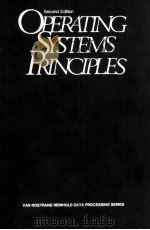
- Operating Systems Principles Second Edition
- 1984 Van Nostrand Reinhold Company Inc
-
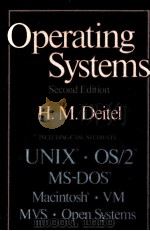
- AN INTRODUCTION TO OPERATING SYSTEMS SECOND EDITION
- 1990 ADDISON WESLEY PUBLISHING COMPANY
-
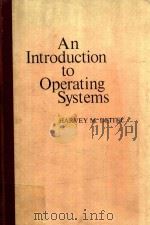
- AN INTRODUCTION TO OPERATING SYSTEMS
- 1983 ADDISON-WESLEY PUBLISHING COMPANY
-
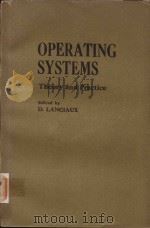
- OPERATING SYSTEMS THEORY AND PRACTICE
- 1979 NORTH-HOLLAND PUBLISHING COMPANY
-

- A PRACTICAL APPROACH TO OPERATING SYSTEMS
- 1989 PWS KENT PUBLISHNG COMPANY
-
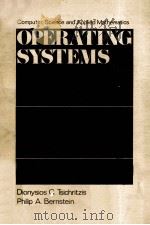
- COMPUTER SCIENCE AND APPLIED MATHEMATICS OPERATING SYSTEMS
- 1974 ACADEMIC PRESS NEW YORK AND LONDON
-
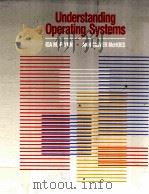
- UNDERSTANDING OPERATING SYSTEMS
- 1991 BROOKS/COLE PUBLISHING COMPANY
-

- OPERATING SYSTEMS
- 1974 MCGRAW-HILL,INC
-
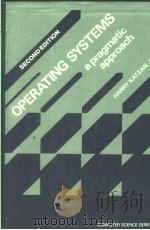
- OPERATING SYSTEMS A PRAGMATIC APPROACH SECOND EDITION
- 1986 VAN NOSTRAND REINHOLD COMPANY
-
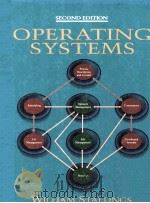
- OPERATING SYSTEMS SECOND EDITION
- 1995 PRENTICE HALL
-
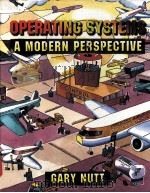
- OPERATING SYSTEMS A MODERN PERSPECTIVE
- 1997 ADDISON-WESLEY
-

- Modern Communication Systems
- 1982 MACMILLAN PUBLISHERS LTD
-
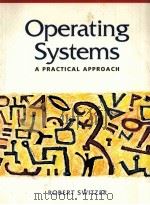
- Operating Systems A Practical Approach
- 1993 Prentice Hall International Ltd
提示:百度云已更名为百度网盘(百度盘),天翼云盘、微盘下载地址……暂未提供。➥ PDF文字可复制化或转WORD

